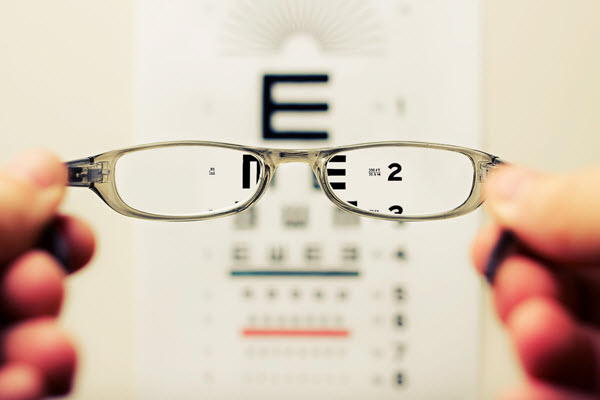The History and Future of Eyewear
By Brian Wallace
December 2, 2019 • Fact checked by Dumb Little Man

Eyewear is the most common form of vision correction, with roughly 64% of the American population having a prescription pair. Unknown to a layperson, the first glasses in recorded history were used and spread by scholarly monks in the 13th century.
Continuing in the 18th century, temples were added to eyewear to maintain the placement of glasses over the ears. The addition of the temple transformed lenses into a hands-free resource. Glasses become universal and accessible to all in the 19th century. During this period, corporations began mass producing frames and lenses.
The eyeglasses we are accustomed to have been completely reshaped by technology — improving their weight, appearance, performance, and functionality. Although 184 million Americans sport eyewear today, the average person would find themselves at a loss for words if asked how eyeglasses work.
On a broad spectrum, there are four conditions in which you'll need eyeglasses for vision correction: astigmatism, myopia, hyperopia, and presbyopia. While I’m sure you are familiar with each, or most of the aforementioned terms, defining them may present strain.
To describe simply, an astigmatism is a light refraction issue. 36% of prescription lens-wearers who suffer from astigmatism experience blurry vision due to imperfectly curved corneas. Also, an astigmatism has the potential to amalgamate with other vision issues, such as myopia and hyperopia.

Myopia is commonly known as nearsightedness, affecting 33% of eyeglass-wearers. A simple Google Search defines nearsightedness as the inability to see objects clearly unless they are fairly close to the eyes. Biologically, myopia is caused when light (rays) cannot focus on the retina, the light-sensitive layer resting on the back of the eyeball that's responsible for middle-manning communication between lights and nerves that create images in the brain.
As a result, light rays focus in front of the retina instead of directly on it. Prescription lenses catering to myopia correct the vision impediment by diverging light rays backward. Opposite of, and less common to, myopia; hyperopia is the condition of farsightedness, found in just 4% of eyeglass wearers. Farsightedness is the inability to see things clearly, with emphasis on visuals and items close to the eye.
As previously implied, standard vision is obtained when light is focused directly on the retina rather than in front or behind it. When farsighted, light touches behind the retina. Prescription lenses correcting this impairment shifts light rays forward. Presbyopia, meanwhile, is simply age-related farsightedness, sharing the same biological reasoning as hyperopia. This condition affects 25% of people worldwide.
See Also: Revisiting What You Need To Know About Eye Health
In connection to the four conditions causing the need for prescription eyewear, there are four types of lens: convex, convex, multifocal, and progressive lenses. Curved lenses perform by bending light rays as they approach the retina to either push light in front or behind the retina.
In cases of myopia or nearsightedness, there is a concave lens prescribed because the distance between the eye’s lens and retina is much longer than it should be. Concave lenses perform by bending light toward the bottom and the top of the lens, pushing the focal point back to the retina.
The stronger the lens, the closer the focal point is to the lens. On the other hand, a concave lens is used to correct farsightedness. This performs by spreading light away from the center of the lens, moving the focal point closer to the top.

A multifocal lens is separated into 2-3 segments to correct an array of vision issues. This can include correction for distance, near, and intermediate vision. For example; in a multifocal lens, the top section can contain a prescription to treat intermediate vision, the middle to treat distance, and the bottom to treat near vision.
Different from this, progressive lenses have the same benefits as bifocals or trifocals — excluding visible lines within the lens. The latest advancements in lens technology include reduced glare and sunlight protection, better lens materials such as high-index plastic, and abilities to filter wavelengths for color enhancement and blue light blocking.
The future of eyewear is expected to consist of smart glasses, nanodrops, and brain implants known as the Visual Cortical Prosthesis System. For further implementation, researchers are developing auto-focusing smart glasses using eye-tracking technology sensors to focus near or far, depending on where you are looking.
See Also: Eye Safety In The Workplace: Effective Ways To Protect Your Vision
The world of vision is rapidly changing, and technology is helping along every step of the way. Read more below to paint a visual representation of what the future of eyewear has in store for us.

Brian Wallace
Brian Wallace is the Founder and President of NowSourcing, an industry leading infographic design agency based in Louisville, KY and Cincinnati, OH which works with companies that range from startups to Fortune 500s. Brian also runs #LinkedInLocal events nationwide, and hosts the Next Action Podcast. Brian has been named a Google Small Business Advisor for 2016-present and joined the SXSW Advisory Board in 2019.

